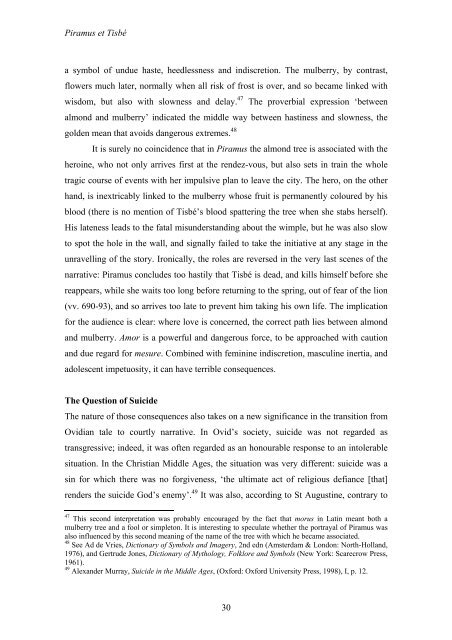You also want an ePaper? Increase the reach of your titles
YUMPU automatically turns print PDFs into web optimized ePapers that Google loves.
Piramus et Tisbé<br />
a symbol of undue haste, heedlessness and indiscretion. The mulberry, by contrast,<br />
flowers much later, normally when all risk of frost is over, and so became linked with<br />
wisdom, but also with slowness and delay. 47 The proverbial expression ‘between<br />
almond and mulberry’ indicated the middle way between hastiness and slowness, the<br />
golden mean that avoids dangerous extremes. 48<br />
It is surely no coincidence that in Piramus the almond tree is associated with the<br />
heroine, who not only arrives first at the rendez-vous, but also sets in train the whole<br />
tragic course of events with her impulsive plan to leave the city. The hero, on the other<br />
hand, is inextricably linked to the mulberry whose fruit is permanently coloured by his<br />
blood (there is no mention of Tisbé’s blood spattering the tree when she stabs herself).<br />
His lateness leads to the fatal misunderstanding about the wimple, but he was also slow<br />
to spot the hole in the wall, and signally failed to take the initiative at any stage in the<br />
unravelling of the story. Ironically, the roles are reversed in the very last scenes of the<br />
narrative: Piramus concludes too hastily that Tisbé is dead, and kills himself before she<br />
reappears, while she waits too long before returning to the spring, out of fear of the lion<br />
(vv. 690-93), and so arrives too late to prevent him taking his own life. The implication<br />
for the audience is clear: where love is concerned, the correct path lies between almond<br />
and mulberry. Amor is a powerful and dangerous force, to be approached with caution<br />
and due regard for mesure. Combined with feminine indiscretion, masculine inertia, and<br />
adolescent impetuosity, it can have terrible consequences.<br />
The Question of Suicide<br />
The nature of those consequences also takes on a new significance in the transition from<br />
Ovidian tale to courtly narrative. In Ovid’s society, suicide was not regarded as<br />
transgressive; indeed, it was often regarded as an honourable response to an intolerable<br />
situation. In the Christian Middle Ages, the situation was very different: suicide was a<br />
sin for which there was no forgiveness, ‘the ultimate act of religious defiance [that]<br />
renders the suicide God’s enemy’. 49 It was also, according to St Augustine, contrary to<br />
47 This second interpretation was probably encouraged by the fact that morus in Latin meant both a<br />
mulberry tree and a fool or simpleton. It is interesting to speculate whether the portrayal of Piramus was<br />
also influenced by this second meaning of the name of the tree with which he became associated.<br />
48 See Ad de Vries, Dictionary of Symbols and Imagery, 2nd edn (Amsterdam & London: North-Holland,<br />
1976), and Gertrude Jones, Dictionary of Mythology, Folklore and Symbols (New York: Scarecrow Press,<br />
1961).<br />
49 Alexander Murray, Suicide in the Middle Ages, (Oxford: Oxford University Press, 1998), I, p. 12.<br />
30
















